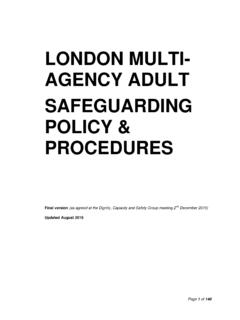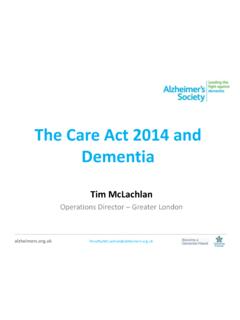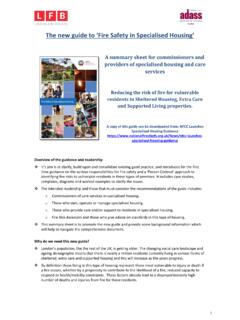Transcription of LEARNING FROM SARS: A REPORT FOR THE LONDON …
1 LEARNING FROM SARS: A REPORT FOR THE LONDON SAFEGUARDING ADULTS BOARD. SUZY BRAYE AND MICHAEL PRESTON-SHOOT. 18th July 2017. Contents Executive summary .. 2. 1. Introduction .. 8. 2. Methodology .. 9. 3. The nature of the SARs .. 10. Case characteristics .. 10. SAR characteristics .. 12. Number and type of recommendations .. 17. 4. The content of the 18. Domain 1: Direct practice with the individual .. 18. Domain 2: Organisational features that influenced how the practitioners worked .. 27. Interprofessional and interagency collaboration .. 36. SABs interagency governance role .. 42. 5. Recommendations made in the SARs .. 46. Recommendations to improve direct practice .. 46. Recommendations to strengthen organisational contexts.
2 49. Recommendation to improve interprofessional and interagency collaboration .. 56. Recommendations relating to the governance role of the SAB .. 59. 6. Integrative discussion .. 62. SAR quality .. 62. SAR commissioning .. 63. Themes within the content of the SARs .. 64. Recommendations arising from the SARs .. 67. 7. Conclusions .. 68. 8. 70. References .. 72. Appendix 1: The analytic framework .. 74. 1. LEARNING FROM SARS: A REPORT FOR THE LONDON SAFEGUARDING ADULTS BOARD. SUZY BRAYE AND MICHAEL PRESTON-SHOOT. EXECUTIVE SUMMARY: JULY 2017. 1. Introduction This project undertook an analysis of the nature and content of 27 safeguarding adults reviews commissioned and completed by LONDON Safeguarding Adults Boards since implementation of the Care Act 2014 on 1st April 2015, up to 30th April 2017.
3 Of the 30. LONDON Boards, 17 submitted reviews for analysis, in numbers varying between one and four. This project formed part of, and was overseen by a LONDON SAR Task and Finish Group, whose work plan also included to consider the establishment of a repository of LONDON SARs, to develop quality markers for SARs, to disseminate relevant lessons from LONDON SARs and methods to measure the impact of LEARNING from SARs, and to establish a repository of SAR. reviewers and methodologies. 2. The nature of the reviews Demographics: More cases involved men than women. All age groups were represented, with an emphasis on older old people. Ethnicity was not routinely recorded. Just under half the reviews related to people in some form of group living, predominantly residential care.
4 Type of abuse: Organisational abuse was the most common form of abuse and neglect present in the cases reviewed, followed by self-neglect and combined forms of abuse and neglect. Three-quarters of the reviews took place following the death of the person involved. Type of review: Almost all the reviews were statutory reviews, the circumstances in which they were commissioned met the grounds set out in the Care Act 2014 under which a review must take place. Most reports did not state the source of the SAR referral. Methodologies: The most common methodology, employed in nine of the reviews, was the use of chronologies and independent management reports submitted to a review panel by agencies involved with the individual.
5 Six reviews employed a SCIE systems model, with the remainder employing hybrid or custom-built models. The period upon which the reviews focused varied considerably, from two weeks to several years, but in some cases was not even specified. Despite statutory guidance advice that lead reviewers should be independent of the agencies involved, in four cases the degree of independence was questionable. Involvement: In none of the cases where the adult was still alive did the review indicate what consideration had been given to their involvement. Family members contributed to half of all the reviews; in most of the other cases participation had been offered and declined. Length of review process: In almost half the cases, it was not possible to identify how long the review process had taken.
6 Of the rest, only two were completed within the advised timescale of 6 months; others noted delays due to parallel processes, poor quality information (and in one case refusal to engage) from participating agencies, or other methodological challenges. Length of REPORT : The documents made available to the project for analysis varied in length between 2 and 98 pages. While many boards submitted full reports, some chose to submit 2. only an executive summary or briefing note, limiting the depth of analysis that could be undertaken in those cases. The full reports ranged between 12 and 97 pages, the median being 33. The executive summaries ranged between 2 and 18 pages. Both brevity and undue length could inhibit rather than add to the coherence of the unfolding story and analysis.
7 Number of recommendations: The reports contained a variable number of recommendations, anything between 3 and 39. In 11 reviews, all recommendations were directed at the Board, while in others both the Board and specific agencies were named the most frequently named being Adult Social Care. In some SARs the recommendations were framed more broadly, directed at unnamed agencies. Recommendations tended to focus on measures designed to improve single and multiagency performance in the local context, rather than upon legal, political and financial systems that impact upon practice; only one SAR contained a recommendation addressed at a national body. Publication: Only eight reports had so far been published, with a further 4 executive summaries in the public domain.
8 This may be a reflection of the timing of the project rather than an indication of the proportion of reports that will eventually be published. 3. The content of the reviews The LEARNING identified in the SAR reports related to four key domains of the safeguarding system: the quality of direct practice with the individual; organisational factors that influence practice;. interprofessional and interagency collaboration; and the SAB's interagency governance role. The quality of direct practice with the individual: Significant LEARNING emerged in relation to a range of aspects of direct practice: Mental capacity: Missing or poorly performed capacity assessments, and in some cases an absence of explicit best-interests decision-making.
9 Risk: Absence or inadequacy of risk assessment, failure to recognise persistent and escalating risks, failure to act commensurate with risk;. Making safeguarding personal: (a) Lack of personalised care and focus on needs, wishes and preferences, insufficient contact, reliance on the view of others; (b) Personalisation prioritised to the exclusion of other considerations such as risk to others;. Working with family members: failure to involve carers, and/or to recognise their needs, absence of attention to complex family dynamics;. Understanding history: lack of curiosity about the meaning of behaviour; failure to recognise key features in life histories;. Challenges of engagement: lack of persistence and flexibility in working with reluctance to engage, lack of time to build trust and continuity.
10 Focus on relationship. Organisational factors that influence how practitioners work: The SARs identified LEARNING too about the organisations in which practice was located: Records and recording: key information in case documentation absent or unclear; failure to consult records; technology shortcomings that compromised recording practice or easy access to information;. 3. Safeguarding literacy: knowledge and confidence of staff; failure to recognise safeguarding concerns and cumulative patterns;. Management oversight of cases: absence of systems to alert managers to errors or omissions; lack of proactive scrutiny; practitioners' failure to escalate; inadequate response to escalation;. Staff working with inadequate resources; financial constraint; service demands affecting time available; absence of specialist placements.





